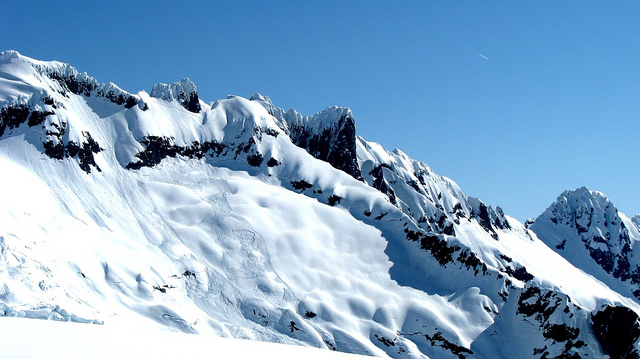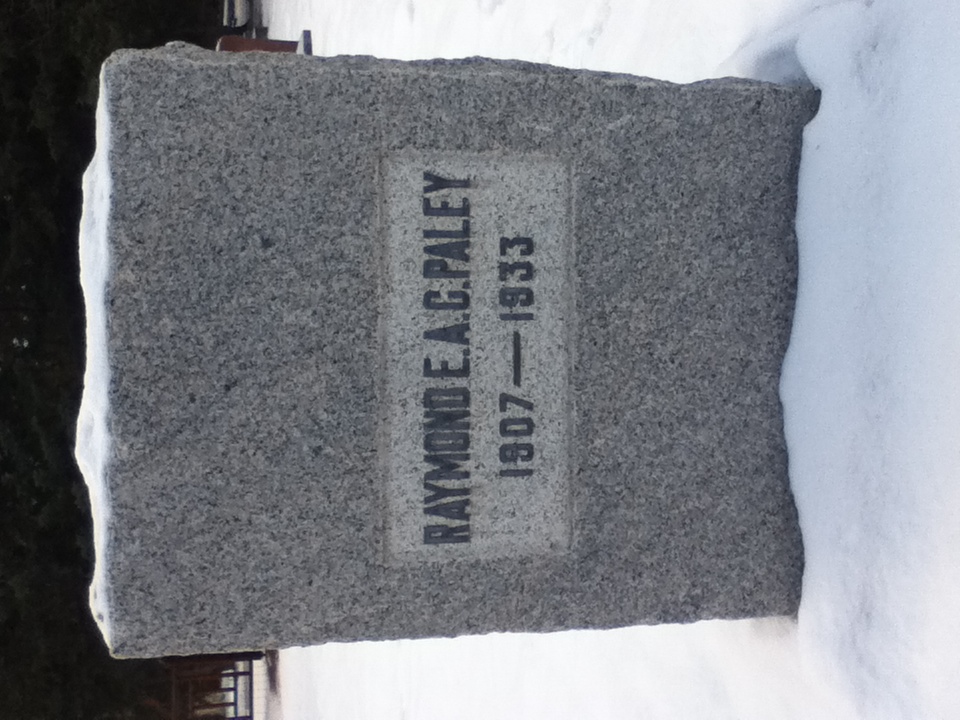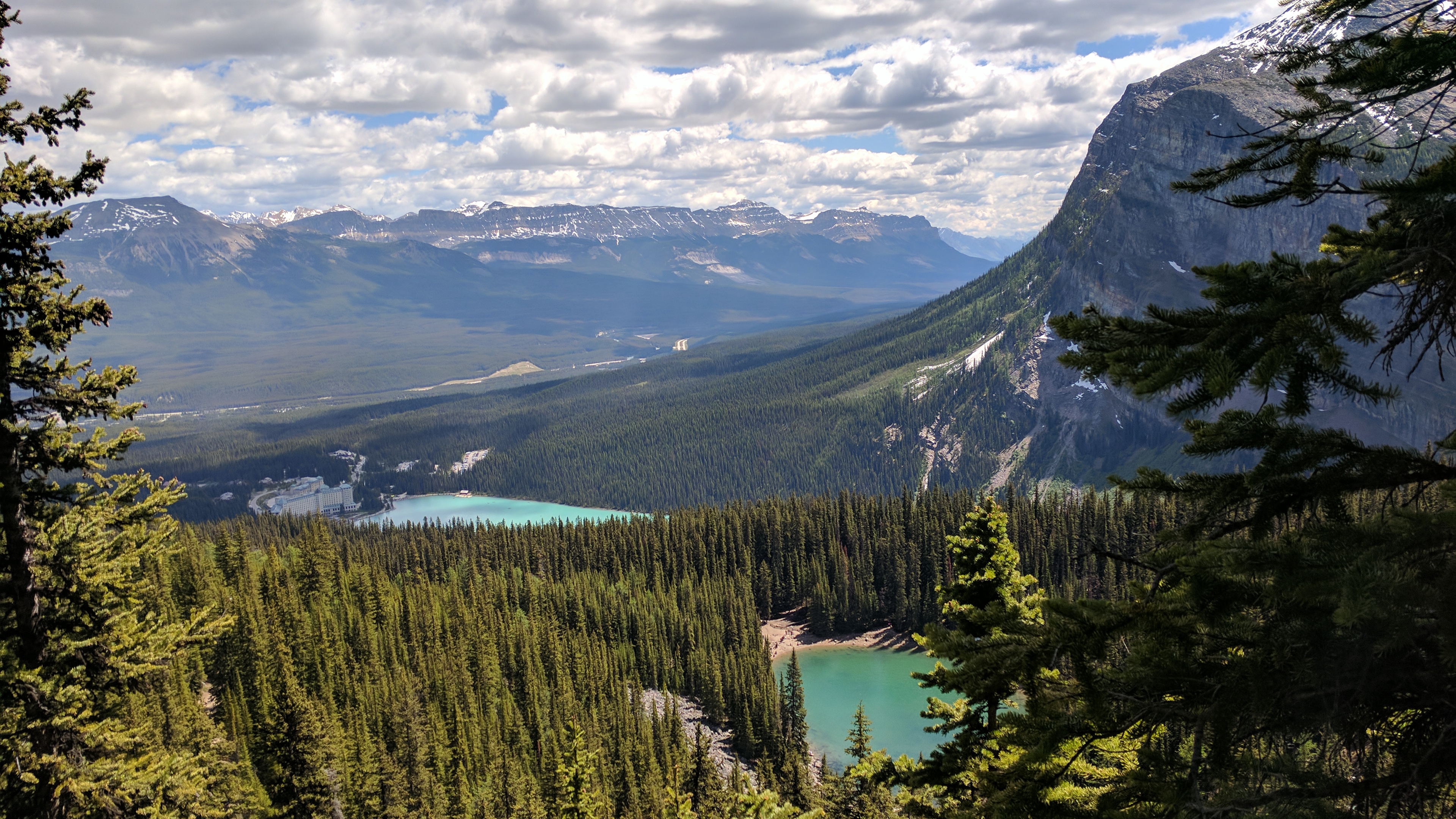|
Fossil Mountain (Alberta)
Fossil Mountain is a mountain located south of Skoki Mountain in Banff National Park, Canada. The mountain was named in 1906 by M.P. Bridgland, of the first ascent party, after the numerous fossils that can be found on its slopes. Fossil Mountain is the site of the first known skiing fatality in the Canadian Rockies. On April 7, 1933, Raymond Paley died in a slab avalanche when he attempted to ski down the mountain after skiing almost to the top. In February 1988, cousins Dan and Wayne Hugo (29 and 27 respectively) were hiking and skiing on Fossil Mountain when an avalanche, which they may have triggered, occurred. They both died. __NOTOC__ Routes The scrambling route ascends easy scree slopes from Deception Pass (Alberta), Deception Pass. Due to these easy slopes, the mountain is sometimes ascended in winter by skiers. Gallery Fossil Mountain seen from Ptarmigan Lake.jpg, Fossil Mountain seen from Ptarmigan Lake References External links Fossil Mountain Route Beta< ... [...More Info...] [...Related Items...] OR: [Wikipedia] [Google] [Baidu] |
Slate Range (Alberta)
The Slate Range is a mountain range of the Canadian Rockies, located in Banff National Park, Canada. The range is named after slate, the primary composition of the mountains in the area. The Lake Louise Ski Resort is on the southern slopes of this range. Peaks This range includes the following mountains and peaks: See also * Ranges of the Canadian Rockies References {{Canadian Rockies, state=collapsed Slate Range (Alberta), Mountains of Banff National Park ... [...More Info...] [...Related Items...] OR: [Wikipedia] [Google] [Baidu] |
Fossil
A fossil (from Classical Latin , ) is any preserved remains, impression, or trace of any once-living thing from a past geological age. Examples include bones, shells, exoskeletons, stone imprints of animals or microbes, objects preserved in amber, hair, petrified wood and DNA remnants. The totality of fossils is known as the ''fossil record''. Though the fossil record is incomplete, numerous studies have demonstrated that there is enough information available to give a good understanding of the pattern of diversification of life on Earth. In addition, the record can predict and fill gaps such as the discovery of '' Tiktaalik'' in the arctic of Canada. Paleontology includes the study of fossils: their age, method of formation, and evolutionary significance. Specimens are sometimes considered to be fossils if they are over 10,000 years old. The oldest fossils are around 3.48 billion years to 4.1 billion years old. Early edition, published online before prin ... [...More Info...] [...Related Items...] OR: [Wikipedia] [Google] [Baidu] |
Two-thousanders Of Alberta
Two-thousanders are mountains that have a height of at least 2,000 metres above sea level, but less than 3,000 metres. The term is used in Alpine circles, especially in Europe (e.g. German: ''Zweitausender''). The two photographs show two typical two-thousanders in the Alps that illustrate different types of mountain. The Säuling (top) is a prominent, individual peak, whereas the Schneeberg (bottom) is an elongated limestone massif. In ranges like the Allgäu Alps, the Gesäuse or the Styrian-Lower Austrian Limestone Alps the mountain tour descriptions for mountaineers or hikers commonly include the two-thousanders, especially in areas where only a few summits exceed this level. Examples from these regions of the Eastern Alps are: * the striking Nebelhorn (2,224 m) near Oberstdorf or the Säuling (2,047 m) near Neuschwanstein, * the Admonter Reichenstein (2,251 m), Eisenerzer Reichenstein (2,165 m), Großer Pyhrgas (2,244 m) or Hochtor ( ... [...More Info...] [...Related Items...] OR: [Wikipedia] [Google] [Baidu] |
Scrambles In The Canadian Rockies
''Scrambles in the Canadian Rockies'' is a climbing guidebook by Alan Kane describing scrambling routes of mountains in the Canadian Rockies. It is published by Rocky Mountain Books, located in Calgary, Alberta Alberta is a Provinces and territories of Canada, province in Canada. It is a part of Western Canada and is one of the three Canadian Prairies, prairie provinces. Alberta is bordered by British Columbia to its west, Saskatchewan to its east, t .... The third edition , released in May 2016, has been updated and contains route descriptions for 175 peaks. The peaks are rated from easy to difficult and information on trail heads and the standard routes are covered. '' Backpacker'' magazine has twice featured the book as an expedition guide. The '' Canadian Alpine Journal'' referred to it as a "scree gospel". The book is solely responsible for creating a widespread interest in scrambling up mountain peaks, whether the peaks are in USA or Western Canada. Since first publishe ... [...More Info...] [...Related Items...] OR: [Wikipedia] [Google] [Baidu] |
Deception Pass (Alberta)
Deception Pass is a trail in Banff National Park Alberta, Canada Canada is a country in North America. Its Provinces and territories of Canada, ten provinces and three territories extend from the Atlantic Ocean to the Pacific Ocean and northward into the Arctic Ocean, making it the world's List of coun .... It is named so because it is deceiving in that it looks small but the end never seems to come into sight. It is used to access the Skoki Valley, The Red Deer Lakes, Skoki Mountain and many beautiful smaller alpine lakes. The pass is a challenge for the guests of the Skoki Ski Lodge. It is located between Fossil Mountain and Ptarmigan Peak. References Banff National Park {{AlbertaRockies-geo-stub ... [...More Info...] [...Related Items...] OR: [Wikipedia] [Google] [Baidu] |
Avalanche
An avalanche is a rapid flow of snow down a Grade (slope), slope, such as a hill or mountain. Avalanches can be triggered spontaneously, by factors such as increased precipitation or snowpack weakening, or by external means such as humans, other animals, and earthquakes. Primarily composed of flowing snow and air, large avalanches have the capability to capture and move ice, rocks, and trees. Avalanches occur in two general forms, or combinations thereof: slab avalanches made of tightly packed snow, triggered by a collapse of an underlying weak snow layer, and loose snow avalanches made of looser snow. After being set off, avalanches usually accelerate rapidly and grow in mass and volume as they capture more snow. If an avalanche moves fast enough, some of the snow may mix with the air, forming a powder snow avalanche. Though they appear to share similarities, avalanches are distinct from slush flows, Mudflow, mudslides, Landslide#Debris landslide, rock slides, and serac collap ... [...More Info...] [...Related Items...] OR: [Wikipedia] [Google] [Baidu] |
Raymond Paley
Raymond Edward Alan Christopher Paley (7 January 1907 – 7 April 1933) was an England, English mathematician who made significant contributions to mathematical analysis before dying young in a skiing accident. Life Paley was born in Bournemouth, England, the son of an artillery officer who died of tuberculosis before Paley was born. He was educated at Eton College as a King's Scholar and at Trinity College, Cambridge. He became a Wrangler (University of Cambridge), wrangler in 1928, and with J. A. Todd, he was one of two winners of the 1930 Smith's Prize examination. He was elected a Research Fellow of Trinity College in 1930, edging out Todd for the position, and continued at Cambridge as a postgraduate student, advised by John Edensor Littlewood. After the 1931 return of G. H. Hardy to Cambridge he participated in weekly joint seminars with the other students of Hardy and Littlewood. He traveled to the US in 1932 to work with Norbert Wiener at the Massachusetts Institute of ... [...More Info...] [...Related Items...] OR: [Wikipedia] [Google] [Baidu] |
Canadian Rockies
The Canadian Rockies () or Canadian Rocky Mountains, comprising both the Alberta Rockies and the British Columbian Rockies, is the Canadian segment of the North American Rocky Mountains. It is the easternmost part of the Canadian Cordillera, which is the northern segment of the North American Cordillera, the expansive system of interconnected mountain ranges between the Interior Plains and the Pacific Coast that runs northwest–southeast from central Alaska to the Isthmus of Tehuantepec in Mexico. Canada officially defines the Rocky Mountains system as the mountain chains east of the Rocky Mountain Trench extending from the Liard River valley in northern British Columbia to the Albuquerque Basin in New Mexico, not including the Mackenzie, Richardson and British Mountains/ Brooks Range in Yukon and Alaska (which are all included as the "Arctic Rockies" in the United States' definition of the Rocky Mountains system). The Canadian Rockies, being the northern segment of ... [...More Info...] [...Related Items...] OR: [Wikipedia] [Google] [Baidu] |
Banff National Park
Banff National Park is Canada, Canada's first National Parks of Canada, national park, established in 1885 as Rocky Mountains Park. Located in Alberta's Rockies, Alberta's Rocky Mountains, west of Calgary, Banff encompasses of mountainous terrain, with many glaciers and ice fields, dense pinophyta, coniferous forest, and alpine landscapes. Provincial forests and Yoho National Park are neighbours to the west, while Kootenay National Park is located to the south and Kananaskis Country to the southeast. The main commercial centre of the park is the town of Banff, Alberta, Banff, in the Bow River valley. The Canadian Pacific Railway was instrumental in Banff's early years, building the Banff Springs Hotel and Chateau Lake Louise, and attracting tourists through extensive advertising. In the early 20th century, roads were built in Banff, at times by war internees from World War I, and through Great Depression-era public works projects. The Icefields Parkway extends from Lake Louis ... [...More Info...] [...Related Items...] OR: [Wikipedia] [Google] [Baidu] |
Mount Richardson (Alberta)
Mount Richardson is the highest mountain of the Slate Range located beside Pika Peak in Banff National Park, Alberta, Canada. The mountain was named in 1859 by James Hector after Sir John Richardson who was the ship's surgeon and naturalist on John Franklin's 1819 and 1825 expeditions into the Arctic. The Lake Louise Mountain Resort is developed on the southern slopes of the Merlin Ridge, which includes Mount Richardson, Ptarmigan Peak, Pika Peak. A backcountry campground is located at the foot of the mountain, near Hidden Lake. The first ascent was made in 1911 by L.L. Delafield who was guided by Edward Feuz jr. Routes The scrambling route (rated easy/moderate) begins from Hidden Lake and ascends the southern slopes to the top. The only real challenge on the ascent are a few rubbly gullies just above the lake. A traverse to Pika Peak Pika Peak is a mountain located between Mount Richardson and Ptarmigan Peak in Banff National Park, Alberta, Canada The mountain was ... [...More Info...] [...Related Items...] OR: [Wikipedia] [Google] [Baidu] |
Skoki Mountain
Skoki Mountain is a mountain located in Banff National Park in Alberta, Canada. It is situated towards the east of the Skoki Valley, at the head of the Red Deer River, and is part of the Slate Range. At the base of the mountain lies Skoki Lodge, a historic ski lodge constructed in 1931, where several routes up to the peak originate. Skoki Mountain was named by James F. Porter in 1911 after the Indian word for marsh or swamp A swamp is a forested wetland.Keddy, P.A. 2010. Wetland Ecology: Principles and Conservation (2nd edition). Cambridge University Press, Cambridge, UK. 497 p. Swamps are considered to be transition zones because both land and water play a role in .... References Two-thousanders of Alberta Mountains of Banff National Park Slate Range (Alberta) {{AlbertaRockies-geo-stub ... [...More Info...] [...Related Items...] OR: [Wikipedia] [Google] [Baidu] |
Mountain
A mountain is an elevated portion of the Earth's crust, generally with steep sides that show significant exposed bedrock. Although definitions vary, a mountain may differ from a plateau in having a limited summit area, and is usually higher than a hill, typically rising at least above the surrounding land. A few mountains are inselberg, isolated summits, but most occur in mountain ranges. mountain formation, Mountains are formed through tectonic plate, tectonic forces, erosion, or volcanism, which act on time scales of up to tens of millions of years. Once mountain building ceases, mountains are slowly leveled through the action of weathering, through Slump (geology), slumping and other forms of mass wasting, as well as through erosion by rivers and glaciers. High elevations on mountains produce Alpine climate, colder climates than at sea level at similar latitude. These colder climates strongly affect the Montane ecosystems, ecosystems of mountains: different elevations hav ... [...More Info...] [...Related Items...] OR: [Wikipedia] [Google] [Baidu] |






